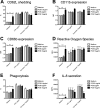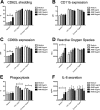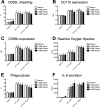Antifungal Drugs Influence Neutrophil Effector Functions
- PMID: 30910895
- PMCID: PMC6535511
- DOI: 10.1128/AAC.02409-18
Antifungal Drugs Influence Neutrophil Effector Functions
Abstract
There is a growing body of evidence for immunomodulatory side effects of antifungal agents on different immune cells, e.g., T cells. Therefore, the aim of our study was to clarify these interactions with regard to the effector functions of polymorphonuclear neutrophils (PMN). Human PMN were preincubated with fluconazole (FLC), voriconazole (VRC), posaconazole (POS), isavuconazole (ISA), caspofungin (CAS), micafungin (MFG), conventional amphotericin B (AMB), and liposomal amphotericin B (LAMB). PMN then were analyzed by flow cytometry for activation, degranulation, and phagocytosis and by dichlorofluorescein assay to detect reactive oxygen species (ROS). Additionally, interleukin-8 (IL-8) release was measured by enzyme-linked immunosorbent assay. POS led to enhanced activation, degranulation, and generation of ROS, whereas IL-8 release was reduced. In contrast, ISA-pretreated PMN showed decreased activation signaling, impaired degranulation, and lower generation of ROS. MFG caused enhanced expression of activation markers but impaired degranulation, phagocytosis, generation of ROS, and IL-8 release. CAS showed increased phagocytosis, whereas degranulation and generation of ROS were reduced. AMB led to activation of almost all effector functions besides impaired phagocytosis, whereas LAMB did not alter any effector functions. Independent from class, antifungal agents show variable influence on neutrophil effector functions in vitro Whether this is clinically relevant needs to be clarified.
Keywords: IL-8; antifungal agents; degranulation; neutrophil effector functions; oxidative burst; phagocytosis; polymorphonuclear leukocytes.
Copyright © 2019 American Society for Microbiology.
Figures







References
-
- Ullmann AJ, Schmidt-Hieber M, Bertz H, Heinz WJ, Kiehl M, Krüger W, Mousset S, Neuburger S, Neumann S, Penack O, Silling G, Vehreschild JJ, Einsele H, Maschmeyer G. 2016. Infectious diseases in allogeneic haematopoietic stem cell transplantation: prevention and prophylaxis strategy guidelines 2016. Ann Hematol 95:1435–1455. doi:10.1007/s00277-016-2711-1. - DOI - PMC - PubMed
-
- Koehler P, Hamprecht A, Bader O, Bekeredjian-Ding I, Buchheidt D, Doelken G, Elias J, Haase G, Hahn-Ast C, Karthaus M, Kekulé A, Keller P, Kiehl M, Krause SW, Krämer C, Neumann S, Rohde H, La Rosée P, Ruhnke M, Schafhausen P, Schalk E, Schulz K, Schwartz S, Silling G, Staib P, Ullmann A, Vergoulidou M, Weber T, Cornely OA, Vehreschild MJ. 2017. Epidemiology of invasive aspergillosis and azole resistance in patients with acute leukaemia: the SEPIA study. Int J Antimicrob Agents 49:218–223. doi:10.1016/j.ijantimicag.2016.10.019. - DOI - PubMed
-
- Cordonnier C, Ribaud P, Herbrecht R, Milpied N, Valteau-Couanet D, Morgan C, Wade A. 2006. Prognostic factors for death due to invasive aspergillosis after hematopoietic stem cell transplantation: a 1-year retrospective study of consecutive patients at French transplantation centers. Clin Infect Dis 42:955–963. doi:10.1086/500934. - DOI - PubMed
-
- Gratwohl A, Baldomero H, Aljurf M, Pasquini MC, Bouzas LF, Yoshimi A, Szer J, Lipton J, Schwendener A, Gratwohl M, Frauendorfer K, Niederwieser D, Horowitz M, Kodera Y. 2010. Hematopoietic stem cell transplantation: a global perspective. JAMA 303:1617–1624. doi:10.1001/jama.2010.491. - DOI - PMC - PubMed
Publication types
MeSH terms
Substances
LinkOut - more resources
Full Text Sources

